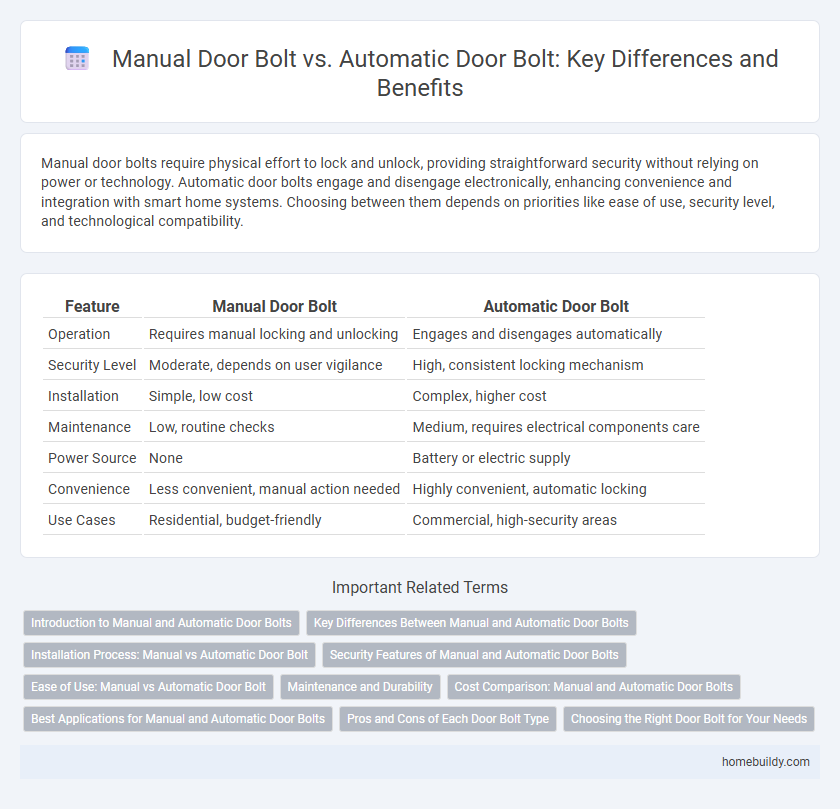Manual door bolts require physical effort to lock and unlock, providing straightforward security without relying on power or technology. Automatic door bolts engage and disengage electronically, enhancing convenience and integration with smart home systems. Choosing between them depends on priorities like ease of use, security level, and technological compatibility.
Table of Comparison
| Feature | Manual Door Bolt | Automatic Door Bolt |
|---|---|---|
| Operation | Requires manual locking and unlocking | Engages and disengages automatically |
| Security Level | Moderate, depends on user vigilance | High, consistent locking mechanism |
| Installation | Simple, low cost | Complex, higher cost |
| Maintenance | Low, routine checks | Medium, requires electrical components care |
| Power Source | None | Battery or electric supply |
| Convenience | Less convenient, manual action needed | Highly convenient, automatic locking |
| Use Cases | Residential, budget-friendly | Commercial, high-security areas |
Introduction to Manual and Automatic Door Bolts
Manual door bolts require physical effort to engage or disengage, typically operated by sliding or lifting a bolt into a secured position, offering straightforward, reliable security for residential and commercial doors. Automatic door bolts activate without human intervention, often integrated with electronic locking systems or sensors, providing enhanced convenience and increased protection in high-security environments. Both types serve to reinforce door security, with manual bolts favored for simplicity and cost-effectiveness, while automatic bolts deliver advanced control and integration with smart home or building security systems.
Key Differences Between Manual and Automatic Door Bolts
Manual door bolts require physical operation to secure or release a door, typically involving sliding or locking mechanisms controlled by hand. Automatic door bolts engage or disengage without manual intervention, often activated by electronic sensors, remote control, or integration with smart security systems. Key differences include the level of convenience, with automatic bolts offering quicker, hands-free locking, while manual bolts provide simplicity and reliability without dependency on power sources.
Installation Process: Manual vs Automatic Door Bolt
Manual door bolts require straightforward installation typically involving basic tools to mount the bolt and strike plate onto the door and frame, making it a quick process ideal for DIY projects. Automatic door bolts demand a more complex installation, often needing precise alignment and electrical connections to integrate with the door's locking mechanism, which may require professional assistance. Both types require secure anchoring for effective security, but automatic bolts generally involve more time and expertise due to their mechanical and electrical components.
Security Features of Manual and Automatic Door Bolts
Manual door bolts offer reliable security through simple mechanical locking mechanisms that resist forced entry and tampering, requiring physical engagement for activation. Automatic door bolts enhance security by engaging locks instantly when the door closes, reducing user error and improving protection against unauthorized access. Both types incorporate hardened steel bolts and tamper-resistant designs, but automatic bolts integrate electronic or sensor-based features for advanced real-time security monitoring.
Ease of Use: Manual vs Automatic Door Bolt
Manual door bolts require physical effort to lock and unlock, making them straightforward but potentially less convenient for frequent use. Automatic door bolts engage and disengage with a simple push or electronic signal, enhancing ease of use and providing faster security access. The choice between manual and automatic door bolts depends on balancing user control with convenience and speed of operation.
Maintenance and Durability
Manual door bolts require regular lubrication and tightening of screws to ensure smooth operation, with durability largely dependent on the quality of materials used and frequency of maintenance. Automatic door bolts often feature self-lubricating components and require less frequent manual adjustment, contributing to extended lifespan and reduced wear under normal usage conditions. Proper upkeep of either type enhances security performance, but automatic bolts typically offer greater long-term reliability with minimal maintenance efforts.
Cost Comparison: Manual and Automatic Door Bolts
Manual door bolts typically cost between $10 and $50, offering an affordable security solution with straightforward installation and minimal maintenance expenses. Automatic door bolts range from $100 to $300 or more, reflecting advanced features such as remote locking, enhanced durability, and integration with smart home systems, which can increase both initial investment and potential maintenance costs. Evaluating long-term value involves considering manual bolts for budget-conscious applications versus automatic bolts for improved convenience and higher security standards.
Best Applications for Manual and Automatic Door Bolts
Manual door bolts are ideal for residential settings and small businesses where user control and cost-effectiveness are priorities, providing reliable security for doors without electricity dependency. Automatic door bolts excel in commercial buildings and high-security areas requiring seamless, remote locking and unlocking integration with access control systems. Selecting the right door bolt depends on security needs, convenience, and environment, with manual bolts offering simplicity and automatic bolts providing advanced protection and automation.
Pros and Cons of Each Door Bolt Type
Manual door bolts offer simplicity, reliability, and cost-effectiveness, making them ideal for straightforward security needs, but they require physical effort and vigilance to lock and unlock. Automatic door bolts provide enhanced convenience and increased security through automatic engagement, reducing the risk of human error, but they tend to be more expensive and dependent on power sources or sensors. Choosing between manual and automatic door bolts depends on prioritizing either manual control and affordability or automated functionality and seamless operation.
Choosing the Right Door Bolt for Your Needs
Manual door bolts provide straightforward security, requiring physical engagement to lock or unlock, making them reliable for controlled access in residential or low-traffic areas. Automatic door bolts enhance convenience and safety by locking doors automatically when closed, ideal for high-traffic or commercial environments where continuous security without manual intervention is essential. Selecting the right door bolt depends on factors like usage frequency, desired security level, and installation environment, ensuring optimal performance and protection tailored to specific needs.
Manual door bolt vs automatic door bolt Infographic

 homebuildy.com
homebuildy.com